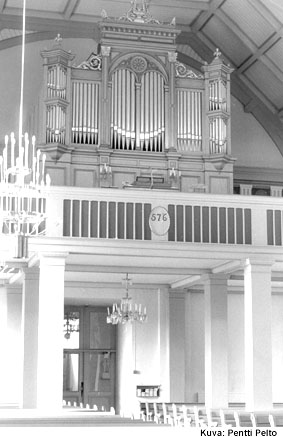
|
HISTORICAL ORGANS IN FINLAND 
Kanta-Loimaa Church- Thulé, Bror Axel 1895
- 22 stops, 2 manuals and pedal
- Barker machine action and pneumatic stop action
The red-brick Kanta-Loimaa Church was completed in 1837. A fire ignited by a lightning strike destroyed all its wood components, but the church was repaired according to a plan by Josef Stenbäck in 1891. Four years later, the church — a large irregular cruciform church with a central dome — acquired an organ in the spacious loft above the main entrance. The organ has remained virtually unchanged. Its sound is typical for the builder, Bror Axel Thulé, and for the period, and it has many significant technical properties.
Appearance
The handsome façade is divided into five parts. In the middle is a large arched flat bound by Corinthian pillars and topped by an imposing capital, further divided into two arched flats. At the edges of the façade stand triangular double-tiered towers. Between these are two rather large flats. The façade is rich in detail, and it is closely related to the slightly older organ façade in Mikkeli Rural Parish Church (1873). The simple side walls fitted to the frames function only as screens.
Technical features
The chests are in line, and under them is a double rise reservoir with twin wedge-shaped feeder bellows and foot levers. The working bellows of the Barker machine connected to the action of Manual I is placed between the façade and the chest. The action between keyboard and the working bellows is pneumatic. The curious thing about this design is that the chests are mechanical B.A. Thulé patent chests, while the action is pneumatic. This is a combination unique in Finnish historical organs.
The graceful console is in front of the organ. The organist sits facing the church. The console is of a type common in the 1890s, with design and layout principles deriving from the mechanical consoles of the previous decade. The manual keys have ebony and celluloid coverings. The round stop knobs are fitted almost in a straight line above the keyboards. Under Manual I there are five small switches actuating the fixed groupings.
Musical properties
The organ has a light touch, as one would expect from a pneumatic action. The pipes are typical for the builder, made of good materials with a high level of professional skill. The Kanta-Loimaa organ was completed a dozen years after the return of Bror Axel Thulé from his trip to Paris. We may assume that influences gained during that trip had by this time become assimilated into his everyday work.
The dynamic organ principle is obvious in the disposition. Manual I is powerful, rich and expansive, ranging from a low Borduna to high Mixtur ranks. Manual II contains quieter stops: a narrow Principal, a Borduna, a Violin and a flute. The organ has no fewer than three overblowing stops. The Pedal forms a strong bass foundation, even including a Bassun (Posaune) stop. All the usual couplings are present, and the fixed groupings make it easy to change dynamics as required. The melody coupling is interesting: it couples the top voice of the texture being played on Manual II to Manual I. Oscar Pahlman considered this function particularly commendable in his inspection statement dated December 21, 1896.
Stop blending is understood, in classical organ building, to refer to the generation of new tonal colours, but blending in late 19th-century organs is something different. Thus, in the Kanta-Loimaa organ we may observe a sort of parallel blending, where the sounds of combined stops are experienced simultaneously and separately instead of becoming mixed with one another.
Disposition
Manual I C-f3 | Manual II C-f3 | Pedal C-d1 |
Borduna 16fot | Gedacht piano 16f | Violon 16f |
Principal 8f | Geig.principal 8f | Subbass 16f |
Gamba 8f | Salicional 8f | Principal 8f |
Flöjt harmoniqve 8f | Flöjt traversiere 8f | Violoncello 8f |
Gedacht 8f | Rörflöjt 8f | Octava 4f |
Octava 4f | Flöjt octaviante 4f | Bassun 16f |
Qvinta 3f | | |
Octava 2f | | |
Mixtur 3 chor | | |
Trompet 8f | | |
| | |
| | |
| | |
|
|
|
Couplings: II-I, I-Ped, II-Ped, I 4’ | | |
Fixed groupings: Piano Mezzoforte Forte Tutti | | |
Melody coupling, general crescendo pedal. | | |
Manual II in swell box. | | |
| | |
| | |
| | |
| | |
| | |
| | |
| | |
| | |
| | |
|